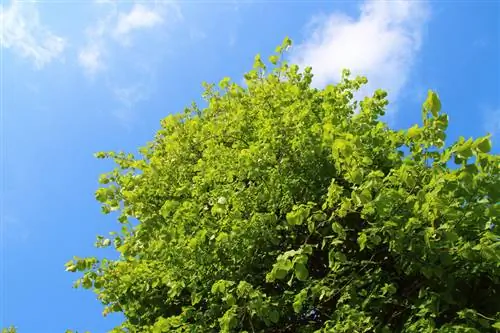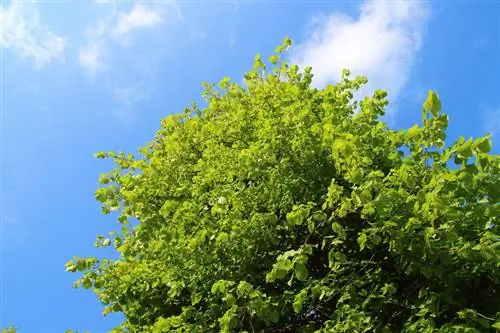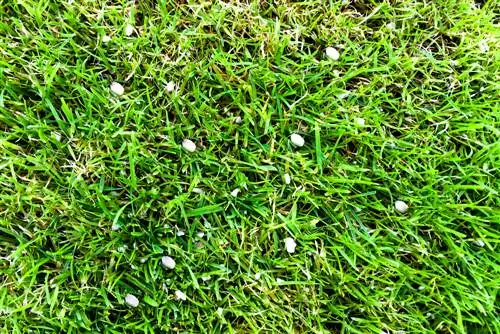- Author admin [email protected].
- Public 2023-12-25 17:45.
- Last modified 2025-01-23 11:19.
With the winter linden tree, a tree will find its way into your garden for eternity, as an age of 1,000 years is not uncommon. It's not just the characteristic crown shape that appeals to us. The tree gives us seductively fragrant flowers, shapely leaves and a golden yellow autumn color. All relevant details about professional cultivation are concretized in the following answers to frequently asked questions.

Planting winter lime trees correctly
In spring or autumn it is time to plant the winter lime tree. Loosen the soil deeply to remove stones, roots and weeds. Dig a spacious planting pit with twice the volume of the root ball. Place the excavated material in a wheelbarrow to mix it with compost and horn shavings. Place the young tree in the middle of the hole and open the bale cloth. With a helping hand holding the trunk, drive a support stake into the ground without damaging the roots. Now fill the cavities with the enriched substrate so that at the end the root ball is flush with the surface of the soil. Now connect the trunk and support post with a rope in eight-shaped loops. Under no circumstances should the material cut into the young tissue. Before you water the tree, create a small watering edge. Planting pruning is not necessary on stone linden trees.
Care tips
The care program for a winter linden tree can be easily managed without extensive gardening experience. The following brief overview provides all the important aspects:
- Water a young tree regularly when the soil has dried out
- Water adult specimens only during dry summers; 1-2 times per week penetrating
- Administer starter fertilization with compost and horn shavings in March/April for the first 2-3 years
- Cutting and thinning during the leafless period between November and March
The tree does not need winter protection because it is completely frost hardy. Since this winter hardiness only develops gradually, cover the root disk thickly with leaves and brushwood during the planting year. In the following years, leave the fallen leaves lying around as natural winter protection, which also releases valuable nutrients to the roots.
Which location is suitable?
The winter lime tree finds excellent living conditions in a sunny to partially shaded location. The powerful heart root system spreads optimally in well-drained, nutrient-rich and humus-rich soil. A sandy-loamy, fresh and not too moist structure meets the wishes of the generation tree perfectly.read more
The correct planting distance
In order to correctly measure the planting distance of a winter lime tree, various aspects are relevant. The distance to buildings ideally corresponds to the expected height. If a limitation of the height is planned through regular cutting measures, this desired value serves as the basis. Otherwise we recommend a distance of 15-25 meters. In a spacious garden or park, half the growth width has proven to be a suitable planting distance. For this type of tree, a distance of 5 to 8 meters applies in every direction. The appropriate distance from neighbors is determined by neighborhood law, which is regulated separately in each federal state. Ask the building or regulatory office about the regional regulations.
What soil does the plant need?
The winter linden tree prefers soil that is not too moist and well-drained. A high nutrient content is beneficial for vitality and abundance of flowers. Therefore, look for a place with sandy-loamy and loose, humus-rich soil. A slightly acidic to slightly alkaline pH of 6.5 to 8 is desirable; However, this does not represent a mandatory requirement for the soil condition.
When is flowering time?
Anyone who has such a long tree life ahead of them takes things slowly. This applies not least to the flowering period. Before a winter linden tree presents itself in its yellowish-white flower dress for the first time, 10 to 20 years pass. This test of patience is nevertheless rewarded with a summer flowering period from June to July, when other trees have long since withered. In addition, the countless umbel-like flowers exude a wonderful honey scent, much to the delight of bees, bumblebees and butterflies.read more
Cut winter linden tree correctly
Their cutting tolerance is legendary. A winter linden tree accepts even a radical cut back into the old wood without complaint. How to cut the tree with expertise:
- Choose a date between November and March, on an overcast, frost-free day
- Cut back branches that are too long, making each cut just above an outward-facing leaf node
- Then thin out the crown thoroughly by cutting off dead wood on the branch
- Remove diseased, rubbing and inward-facing branches
In the first step, saw thick branches about 10 cm from the top of the trunk and then cut them off completely from below. To remove the remaining stub, do not cut into the trunk bark, but leave a small collar.
Watering the winter lime tree
Freshly planted winter linden trees are thirsty companions. Therefore, water a young tree regularly and thoroughly. With increasing age, the need for water decreases. Once the heart root system has established itself, it is best to water during a summer heat period. Otherwise, the magnificent tree is content with the natural rainfall.
Fertilize the winter lime tree properly
In the first 2-3 years of growth, the young tree is grateful for a little organic nourishment to start the growing season. In March/April, work compost and horn shavings superficially into the soil of the root disc with a rake. Then pour generously. An adult winter linden tree then obtains its nutrients on its own using its powerful root system.
Pests
Unfortunately, one of the most resistant pests also has its sights set on the winter lime tree. It is the frost moth, a brown, yellow-speckled butterfly with a wingspan of up to 38 mm. It is not the adult butterflies that cause damage to the tree. Rather, their larvae hatch in spring and feast on the delicate leaves and flowers. An unmistakable symptom - in addition to the feeding marks - are the fine webs with which the brood binds leaves and flowers together. Take action against the pests with Neudorff caterpillar treatment, spruzit or neem seeds. Additionally, wrap rings of glue around the trunk and support post.
Wintering
The winter linden tree sheds its leaves in late autumn and gets through the cold season unscathed. Special precautions for winter storage are therefore not necessary. Frost hardiness has not yet fully developed in the year of planting. We therefore recommend covering the root disk on a young tree thickly with autumn leaves and brushwood.
Propagate winter lime tree
Generative propagation by sowing proves to be time-consuming and delicate for stone linden trees. Since not every nut actually contains seeds, the germination rate is at a low level. In addition, additional measures are required to break the germination inhibition of the hard-shelled cold germs. File the seed shell a little and place the seeds in a bag with moist sand in the vegetable compartment of the refrigerator for 6-8 weeks. Then sow the seeds in small pots with lean substrate. In contrast, breeding offspring using cuttings proves to be much less complicated. To do this, cut non-flowering head cuttings in summer. These are stripped of their leaves in the lower half and can either be put directly into the ground or grown in a pot with potting soil for a few months.
How do I transplant correctly?
In the first 5 years of growth, the winter linden tree can easily change location. The tree initially develops a shallow root system and only later penetrates deeper into the ground. In spring, cut off the root disc all around with a spade, leaving the diameter around two thirds of the current height. Fill the resulting furrow with loose humus soil and water regularly throughout the summer. By autumn, numerous new fine roots will have formed at the root ends, so you can now lift the ball out of the ground. If possible, keep the existing planting depth at the new location.
Is linden tree poisonous?
The winter linden tree is not poisonous. The tree poses no he alth risk to people or animals. Instead, we owe the aromatic lime blossom honey to the wonderfully fragrant flowers. Prepared as a tea, the flowers relieve colds, explicitly alleviating a tormenting cough.
Winter linden tree is not blooming
In the first 10 to 20 years we have to be patient, because the winter lime tree only very rarely puts on its flower dress beforehand. If the tree still does not bloom, there is most likely root competition from older trees. These remove nutrients and water from the soil, so that the stone linden tree has to be content with the meager remainder. In this case, water regularly and apply a mineral-organic long-term fertilizer in March/April and June.
How do summer linden trees and winter linden trees differ?
For hobby gardeners, there are two obvious differences between the two tree species. At up to 40 meters, summer linden trees reach a significantly higher height than winter linden trees, which stretch a maximum of 25 meters towards the sky. Furthermore, the heart-shaped leaves of a summer linden tree with a length of 10-18 cm are noticeably larger than the 6-12 cm smaller winter linden leaves.read more
Trivia
The winter linden tree is considered a mythical symbol of love, not only thanks to its heart-shaped crown. Furthermore, the tree symbolizes hospitality in its most beautiful form. So it's no surprise that the most common name for inns is 'Zur Linde'. In addition, countless names of people, places and streets refer to the linden tree, such as the legendary boulevard in Berlin 'Unter den Linden'.






